After my slightly chaotic visa run in Hong Kong, I hopped off the plane and re-entered the Middle Kingdom. I was back in China, there was no mistaking that. Two steps outside the airport exit I was mobbed by a million shouting and spitting taxi touts.

I took few more days to relax in the great smog cloud that is Chengdu, still the most cosmopolitan place I’ve been in China. I made the pilgrimage to Decathlon (my favourite shop in the world and first I’ve been able to visit since Istanbul) to replace some broken camping stuff. It was finally time to get a new coat – I’d been carrying my mum’s old hand-me-down (apparently she was wearing it when pregnant with me). I need something warmer before I head back into the mountains and it’s great to have one of these fancy down jackets that folds into a tiny pouch rather than a bulky coat that fills half a rear pannier…
Across the road was an Ikea. I walked around the shop for no good reason, just enjoying how familiar everything felt. I wasn’t in China inside there. I paused for a nostalgic hot-dog in the food section. It wasn’t anywhere as good as the 20p ones of my childhood in Croydon so I bought a bottle of Gløgg (Scandinavian muled wine) and made myself comfortable back at the flat.
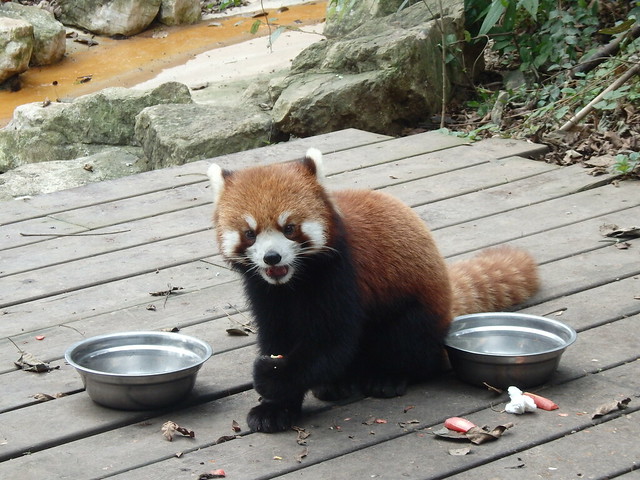
It’s a funny world. Sometimes I feel like I’m on another planet and sometimes I feel like I might as well be right back at home.
It was one of those evenings. Especially because I saw the first familiar face from back home in many, many months. Annie, who I met a few times in when we were studying in Leeds (but never since) spotted me on Tinder, saw we had a bunch of mutual friends, followed my link through to my blog and shot me a message. She was passing through Chengdu that very weekend so we could get a quick drink in. (She says she was just one Tinder to ask locals what’s good to see in the area. Same as me, of course).
It’s a small world.
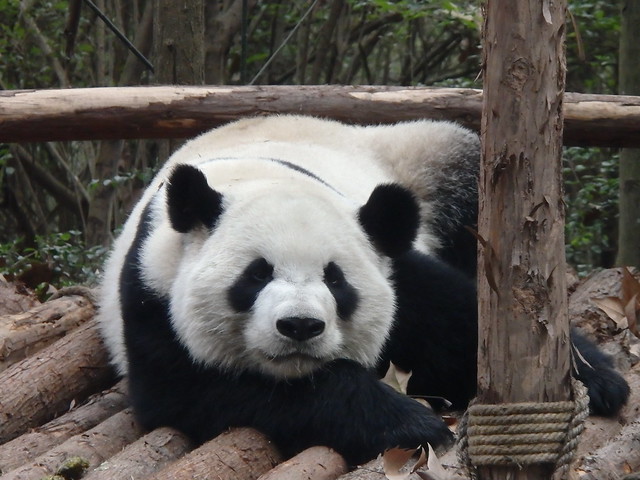
There was one last ‘little’ thing to see before leaving Chengdu – the Giant Panda Research Base. I figured I go should go check it out before leaving town seeing as it’s the city’s main tourist attraction.
I’m not sure what was more enjoyable: checking the pandas out or people watching the Chinese tourists running around with their selfie-sticks trying to get the best snap possible.
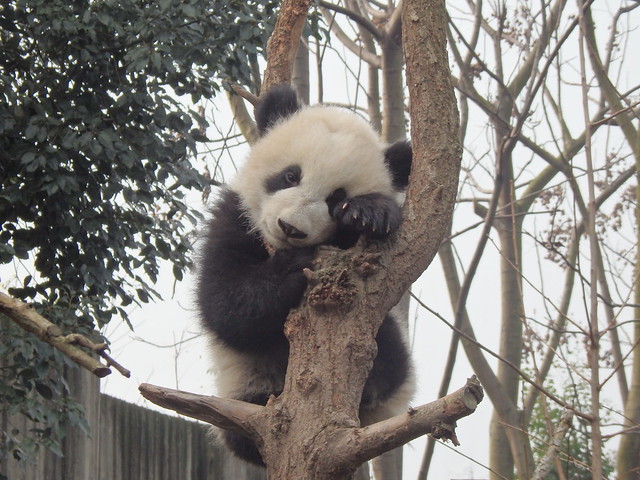
It occurred to me that Chinese New Year falls exactly during the week my new visa expires. Good timing. The whole country shuts down that week, including the PSB office who’d handle my next extension. Suddenly I had a whole week less to reach Shangri-la if I wanted to get another 30 days in the country.
I met up with the cycling guys who ran the charity offering advice to Chinese cyclists riding to Lhasa (the ones who’d made me into a celebrity in the previous China blog). They gave me a list of places I could stay for very cheap but made sure to advise me (once again) against attempting the road at this time of year. ‘Too cold up there’, ‘too much snow & ice’, ‘the mountain roads won’t be passable’ etc.
In their info pack they tell potential cyclists not to attempt the road before March 10th but I took their advice with a pinch of salt. When I showed them the small valley roads I’m planning on cycling in Yunnan province they again advised me against my plans – ‘no people cycle there, no people live there’. That’s exactly why I want to cycle there! Perhaps we’re not quite on the same wavelength…
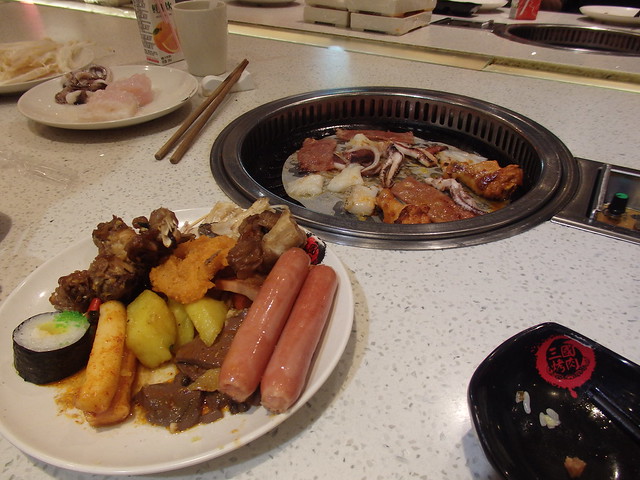
I was happy to be back on the bike, even if the first day riding out of town was incredibly dull. Fortunately I could meet my first Couchsurfing host in China that evening. If you’ve followed this blog you’ll know that I love using CS/Warmshowers as much as possible but those communities haven’t had much presence in this country unfortunately.
Anyway, my host Harry was great. His mum & nan cooked us a feast of a dinner at his grandparents’ village home. The food in China is still the best thing about this country.
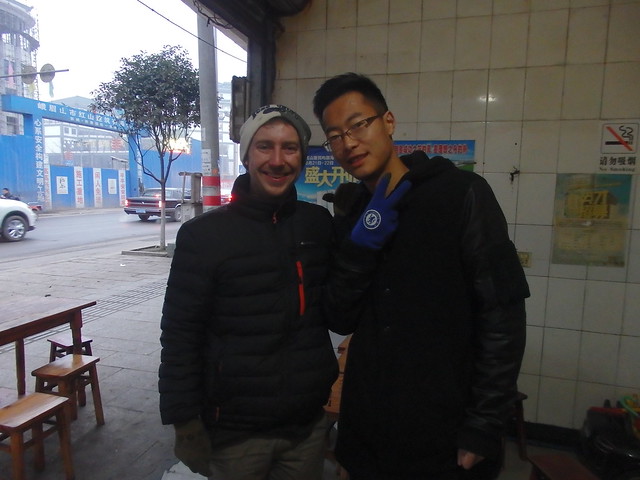
Slowly the mountains began to grow around me. I don’t think I’ve ever felt so nervous about a stretch of road. The last post I wrote about cycling the Tibetan Plateau was covered in snow – but that was about 1,000m lower than what this section has in store for me…
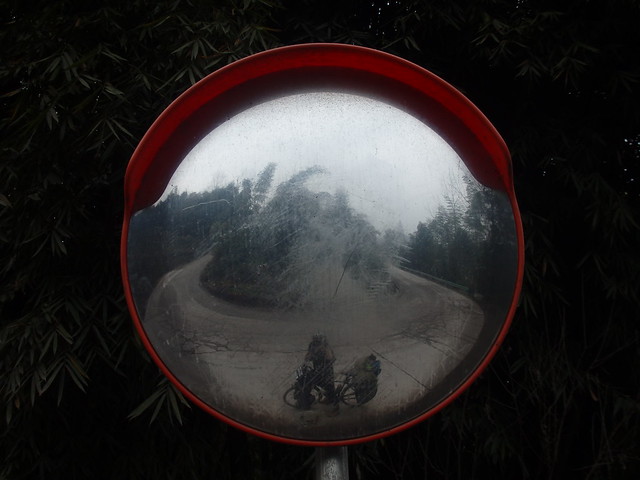

I stopped in a small village and found a room for £3. Hot shower and sit down loo – result! It was just a room above a family home. Downstairs the walls were decorated with the usual Chinese-style posters: a giant portrait of Mao, some horses in a field and a pagoda under a full moon. Then I walked into my room and saw this…
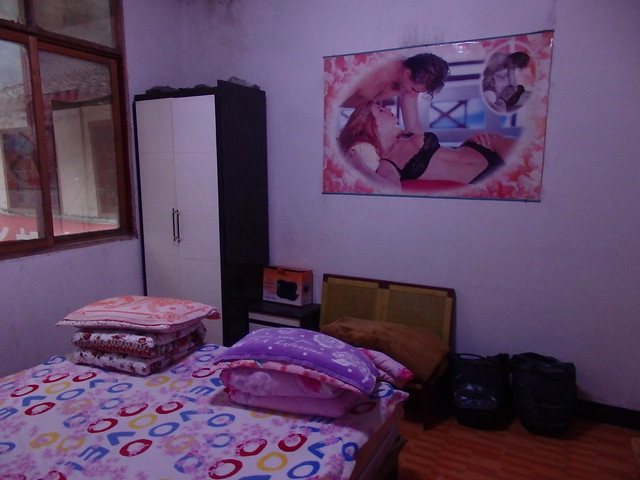
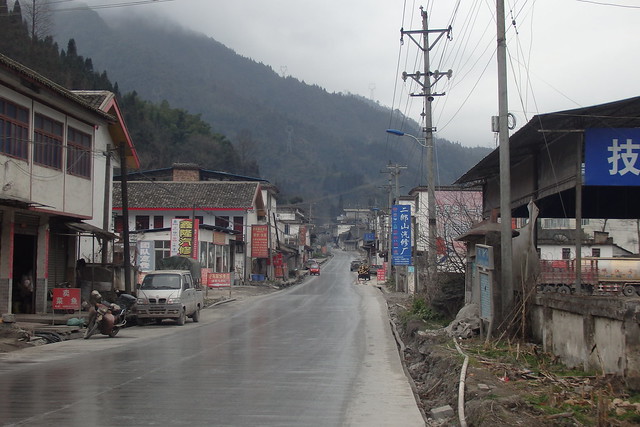
It was one of the strangest things I’ve ever seen! At what point did they think that was an appropriate poster to stick up in the room? Why couldn’t I get the horses or the full moon? It was very strange.
I’ve stayed in some seedy places before but this was just a truckers-stop type room in a tiny village. I took it as a tactless reminder of ‘how little’ I’m getting these days. The only steam in this room was the frozen breath in the air every time I exhaled and the only bed wobbling coming every time a truck drove past and shook the whole house.
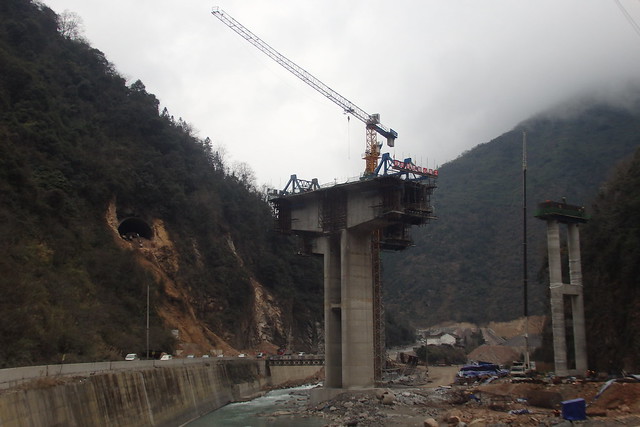
The first pass above 2,000m lay ahead. This was important – if there was already ice down here then I’d be in trouble.
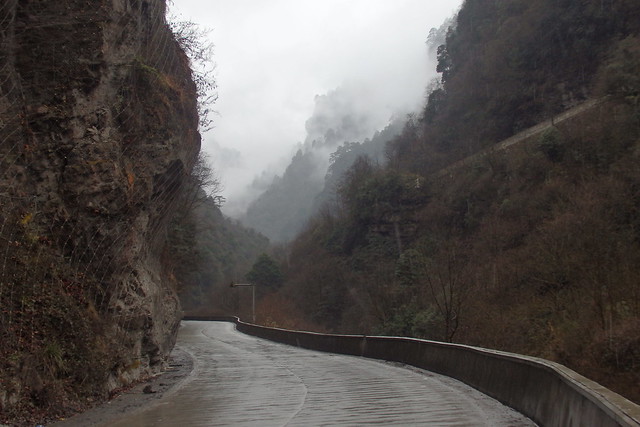

Unfortunately the top was frozen. Patches of ice lined the sides of the roads. You could see on the mountain exactly where the freezing line was. At the bottom of the valley the trees would be a light green jungle colour but slowly they’d fade into dark evergreens and eventually the green would just turn white.
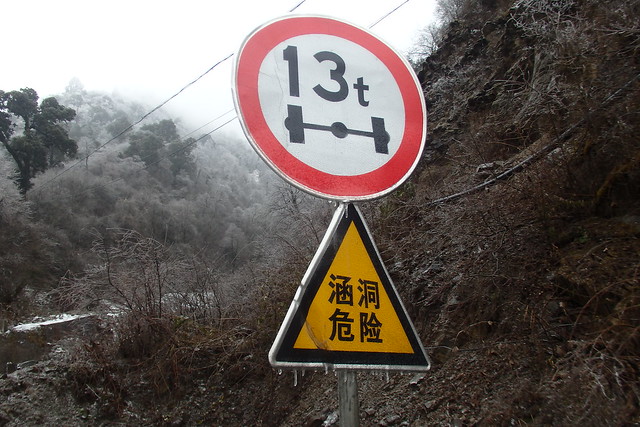
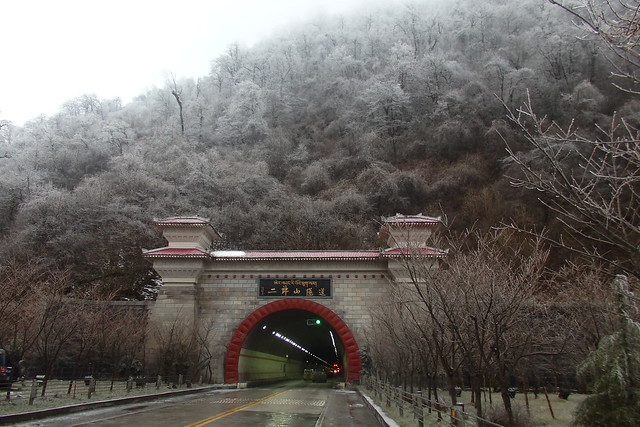
A tunnel cut through the top of the pass. I camped on the other side at just over 2,000m, on the edge of a cliff looking down into the next valley and the town Luding below. I was curious to see how cold the nights would be this high.
It was freezing.
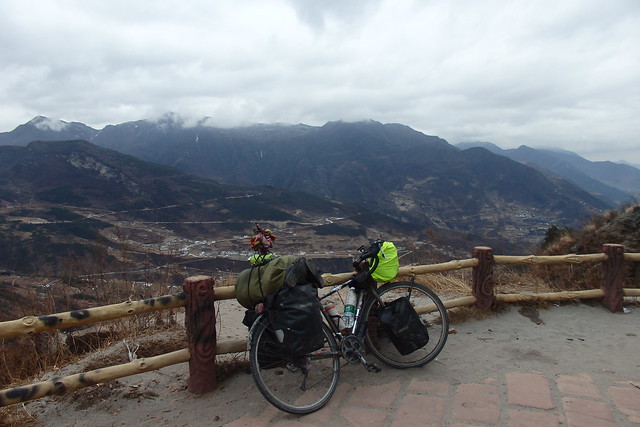
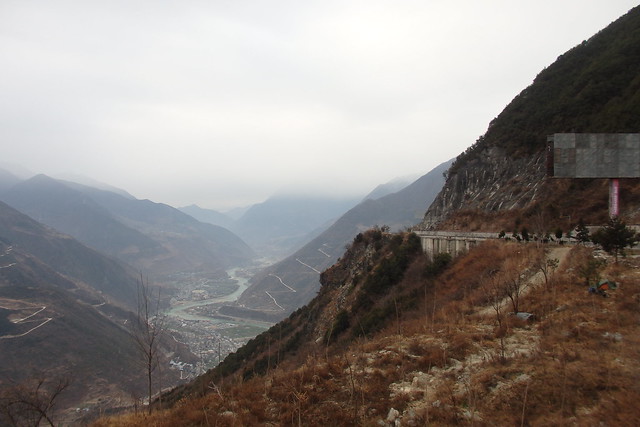
After a lower section along the reservoir below the road started to climb again, this time towards the first 4,000m pass. I took my instructions from my cycling pals in Chengdu too literally and ended up riding past the last place to sleep inside before the top. Not wanting to go back down, I set up camp at about 3,500m.
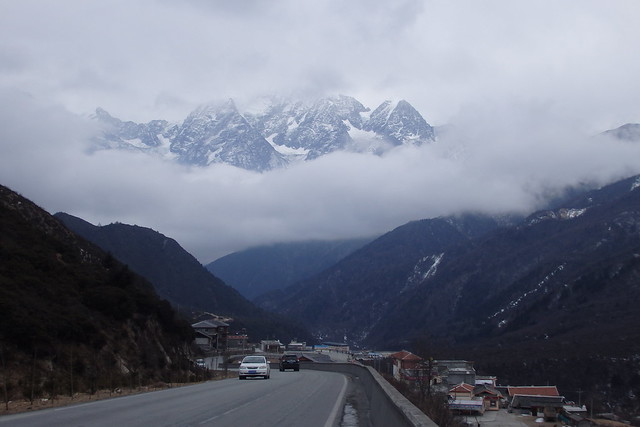
I finally bought a thermometer in Decathlon so now I know for sure how cold it gets. It read -10C inside the tent when I woke up. I’d forgotten how hard life is in the real cold. I didn’t put my water bottles inside my sleeping bag and they’d all frozen solid. I’d been saving a banana for breakfast but it I had to cut the frozen skin off before I could defrost the edible interior in my porridge.
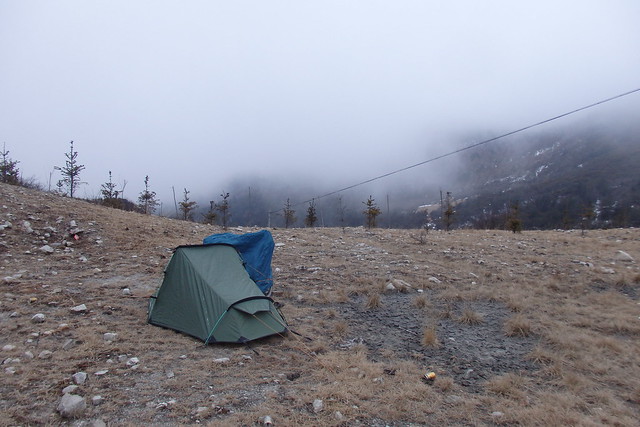
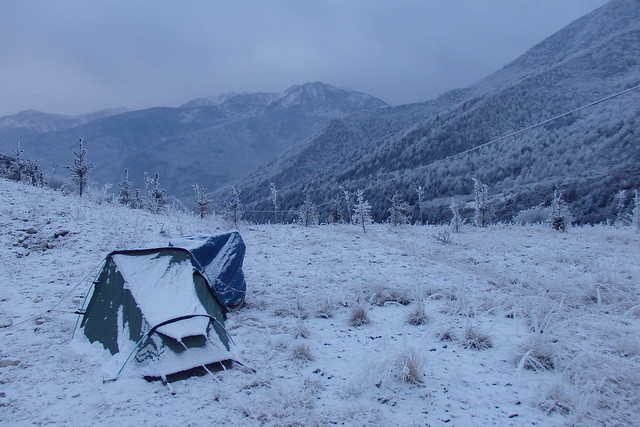
It had snowed during the night. Here we go again. Slowly, slowly inching up the mountain.
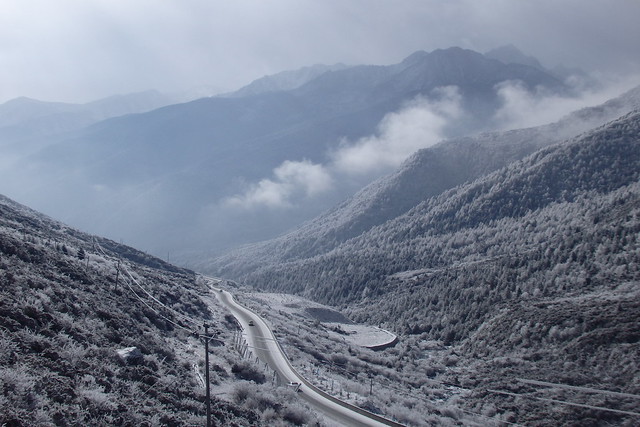
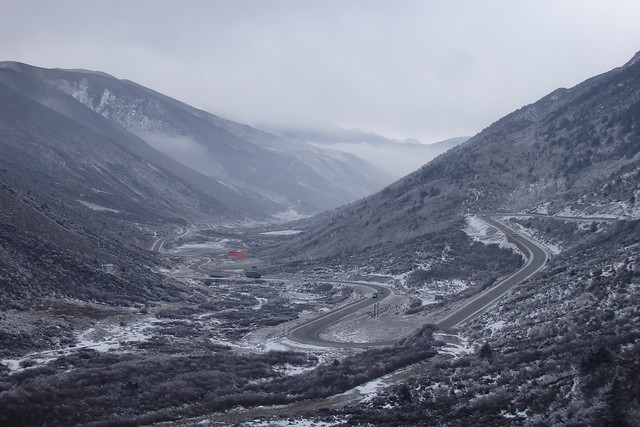
I stopped only for a minute at the top to take a quick pic and pose for a monk who wanted a picture of me next to the shrine at the peak. It was about 4,300 and the air was thin. It was too cold to stick around and I descended as quick as I could out of the snow line.

Over that pass, everything changed. I was back in Tibet. It’s worth clarifying: when I say Tibet I mean the greater Tibetan Plateau region. As a foreigner I’m not allowed into Central Tibet without a permit and guide. Also, when I say the ‘Plateau’ that doesn’t mean it’s all flat and open – this ride was just up and down, up and down…
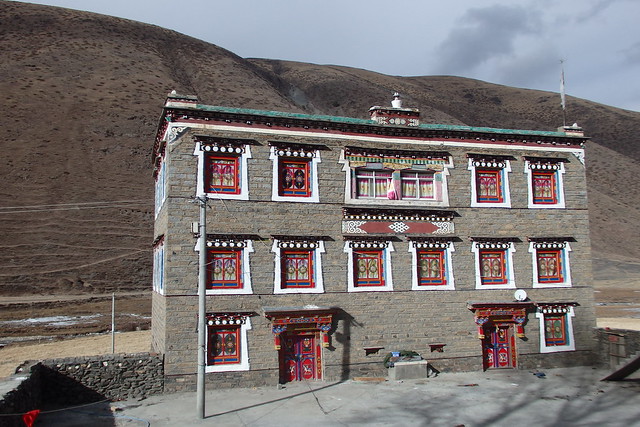
The Chinese faces had changed to Tibetan, the cows were now yak, the farm land was now for grazing and my favourite change was in the village architecture. The villages accompanying me during my last stretch up on the plateau had been scatty and clustered together. Here they were huge, spread out and beautifully ornate. Perhaps the people here just have a little more money. They do, after all, live next to the main road connecting Tibet with the rest of China. That must count for something.
I looked for a place to stay inside at the village Xinduqiao. The place was set up for tourists – hotels and guesthouses lined the streets but everything was closed. It was a ghost town like so many I’ve passed this time of year. A young kid came running out to me and showed to his parents’ guesthouse. They were closed and renovating like everywhere else but opened up for me.
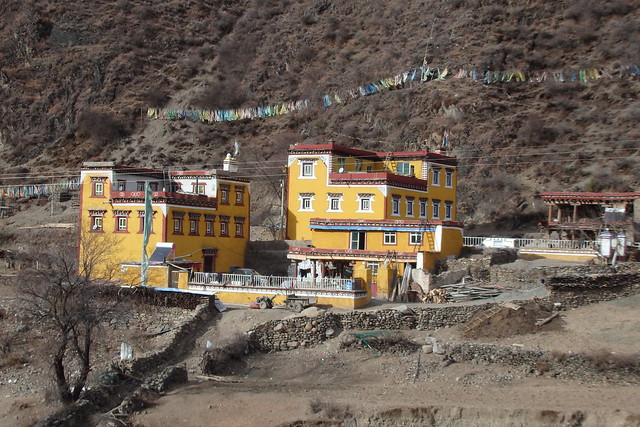
Somehow I feel more welcome in the Tibetan regions than in China. I guess the people are just different. The main change is how people interact with me: the Chinese are masters of the gormless stare, a trait I really despise. Nothing makes you feel like more of an outsider than blank staring. The Tibetans like to get a good look at me (no surprise really – a white bloke with a massive bicycle) but they all shout ‘tashi delek’ or ‘hello’ and wave. That makes a huge difference, when people make the effort to greet me I feel far more welcome.
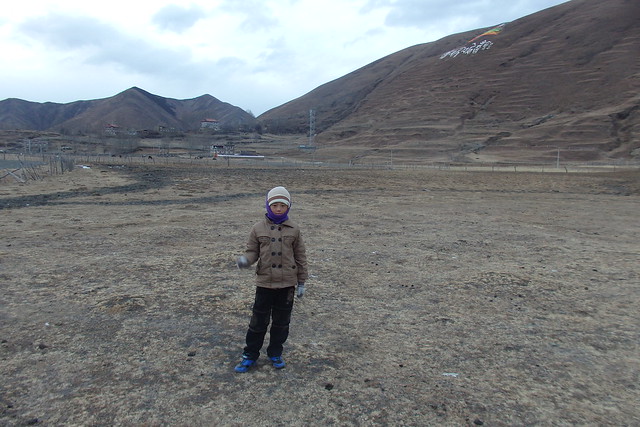
The kid took me on a tour of the village to show me their horses and the family invited me to eat with them. I love the Tibetan aesthetic too – the beautiful design of the houses (especially inside) and the clothes they wear.
There aren’t that many ethnic groups in the world that maintain such a strong identity in their clothing. In other places I passed where people wear very ‘non-western’ clothes it’s partly because they’re completely detached from the rest of the world. It doesn’t feel like that with the Tibetans. Perhaps you just get a re-enforced sense of self-identity when you undergo years of cultural oppression…
Dinner was a sour egg soup and stale bread. Perhaps the Tibetans are too stubborn to admit their Chinese neighbours do the whole ‘food thing’ a lot better…
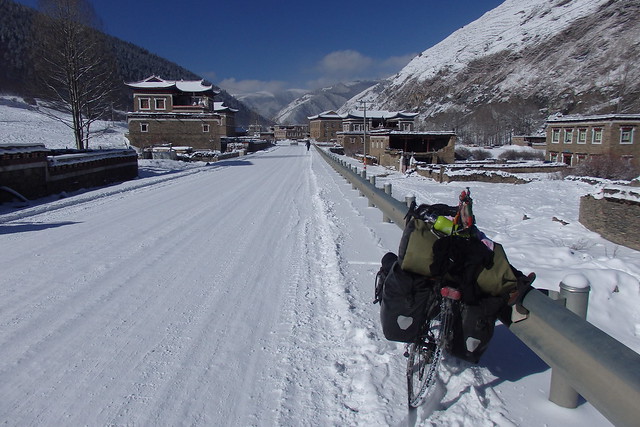
I was pleased to have found a place to sleep inside as it snowed heavily in the night. I wished I had winter tyres with me. But I didn’t. What I did have was a huge pack of zip ties – so I improvised. Better than nothing!
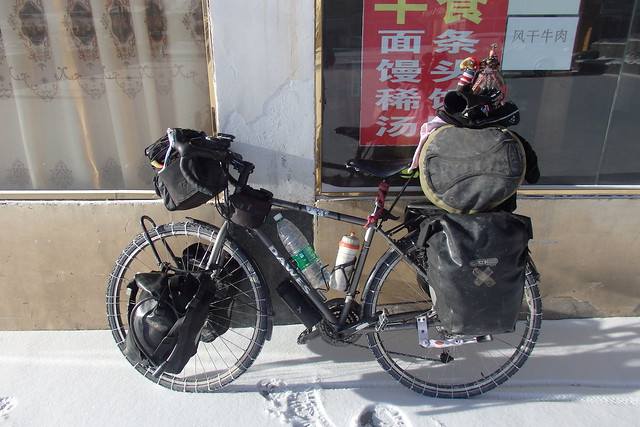
My right knee has started causing me a lot of discomfort over the last few days. I wasn’t sure why (I adjusted anything on my bike) but it was adding to my already long list of concerns. The weather was really bad and I was starting to get worried about reaching Shangri-La in time. I’d justified my ride up into the mountains because I had plenty of time but now I realised I’d need to put in a bunch of big days to make it. Knees are important, especially in the mountains.
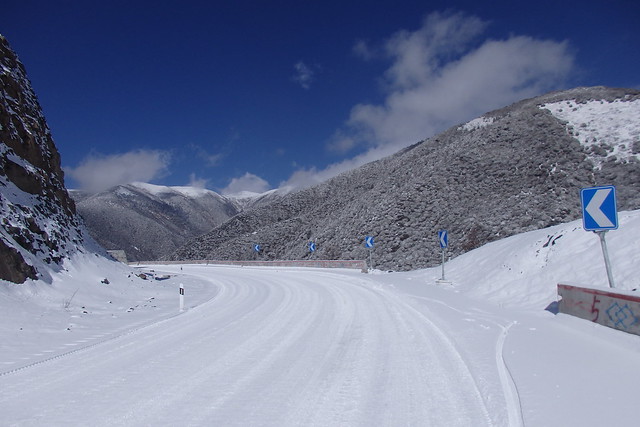
The landscape was stunning but the roads were awful. It took me half an hour just to cross the the other side of the village. Just before the road started to climb to the next pass I had a good long look at my map. This was the point of no return. From Xinduqiao a road led south, down from 4,000m and into safe terrain. I was making very slow progress on this road and already my schedule for arrival at Shangri-La was looking doubtful with this amount of snow. Nevertheless I pushed on. I could always take a bus if everything went pear-shaped and even if the buses weren’t running in the snow then I could probably hitch a ride.

I had to walk to the last section to the pass. I was breathing OK, but the road was covered in a solid inch of ice. I brushed a little snow aside and looked at the surface – it was like an ice rink. Two motorbikes hadn’t spotted the ice and slipped into each other on the way into the tunnel at the pass. They were fine, but walked like me to the entrance.
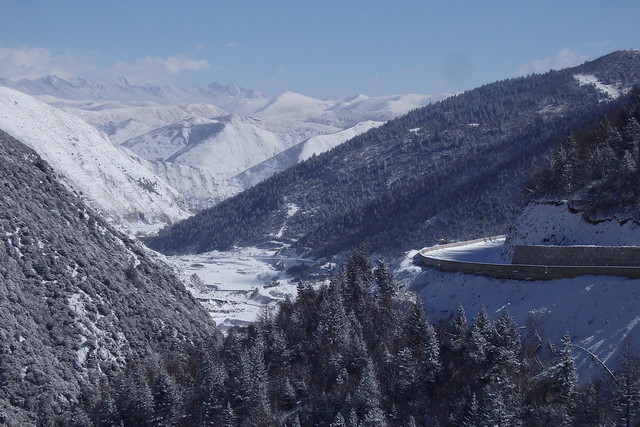
On the other side I sat on a ledge to eat some lunch. I was beginning to really doubt my decision to tackle this road. The cold was a pain, but the road conditions were dangerous. I’d justified this choice by telling myself there was no rush – if I needed to I’d walk, but now that wasn’t an option. Rushing on ice is not a good idea.

But then, all of a sudden. This happened:
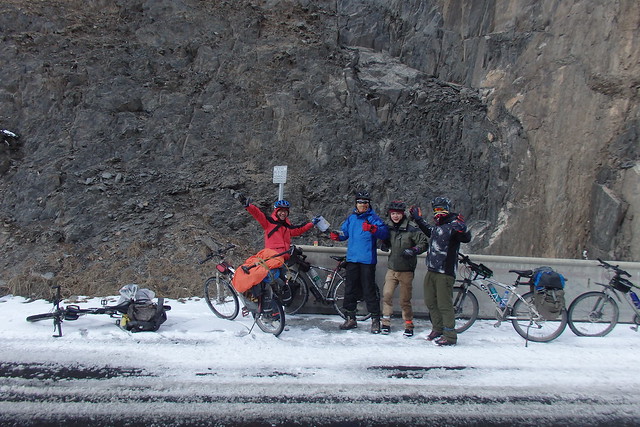
I haven’t seen any other cyclists for months now, but apparently I’m not the only one crazy enough to be attempting these roads in the heart of winter! These four blokes were the nicest bunch. One of them spoke a little English, but the language barrier was manageable and I was thrilled to have some company.
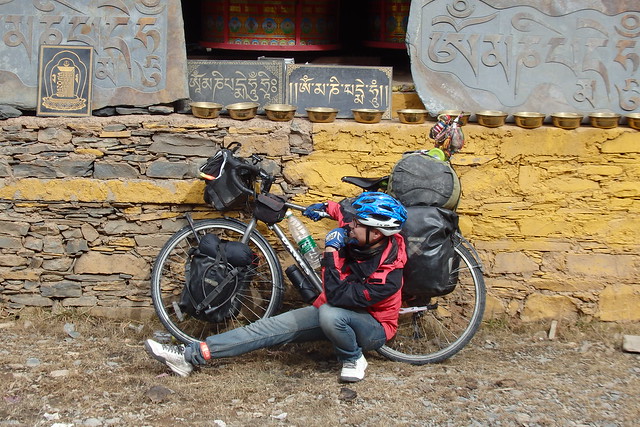
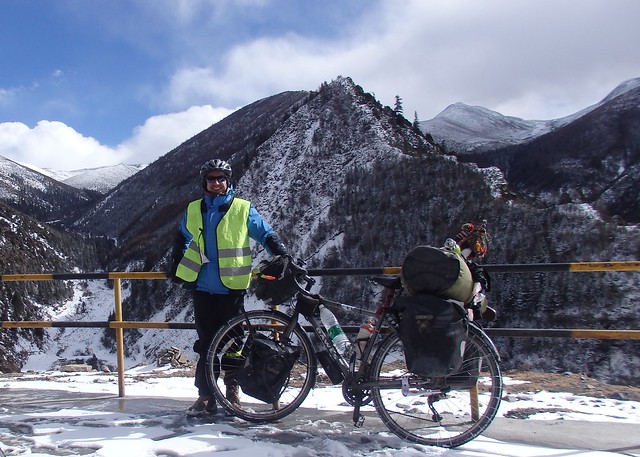
We descended to Yajiang together. With company the challenge seemed less daunting and more of an adventure. We took it in turns walking, slipping, laughing and cursing at the ice as we inched our way down.
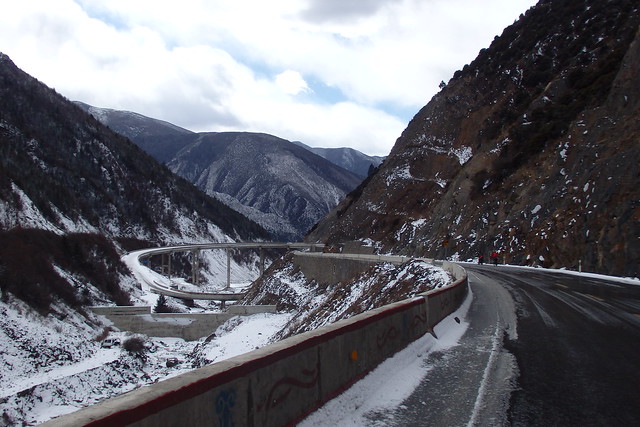
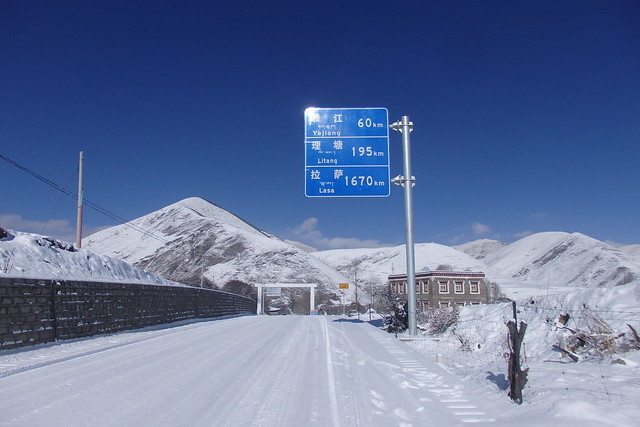
It was amusing to be treated as some kind of cycling veteran. I suppose I must be fairly qualified after a year of cycling. After hearing that I had previous experience cycling above 4,000m they asked if I had any advice for them. They’d all had to walk over the first 4,300m pass (and I took great comfort in the fact that I’d pedaled over the top no problems with at least 4 times as much luggage). I told them that now might be a good time to quit smoking, although I’m sure their mothers had already told them that!

They found us a very cheap place to stay (£2.50 a bed) where I could finally get a much needed shower. The best thing about riding with Chinese is the value they place on food. I normally skimp and cut corners on my diet but with them it was another story. A big multi-dish dinner and a huge portion of stuffed buns for breakfast.

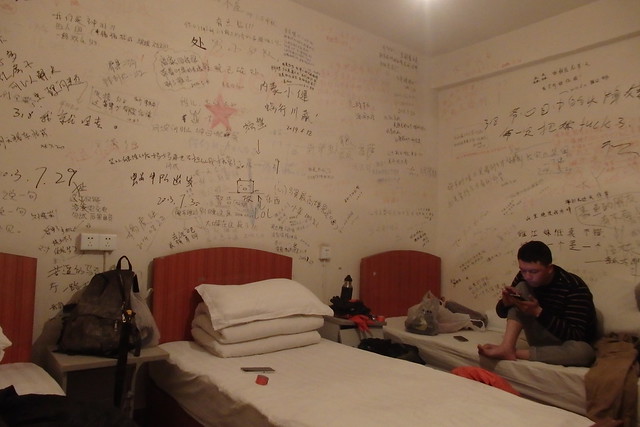

The next day we parted ways. They were sensible and stopped after 1,000m of climbing. None of them had camping gear with them and it was the last place to stop for a long way. I pushed on – the roads were ice free and I figured I should try and climb the pass while the weather was fair. Besides, I was stressing about reaching Shangri-La in time.

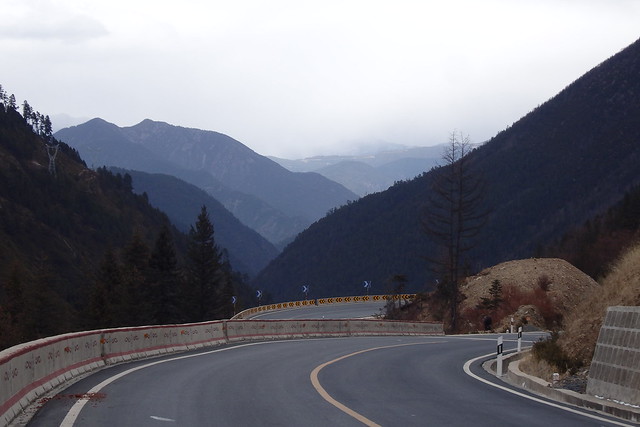

On the other side of the pass everything was frozen. Mountains are often like that – one side will be fine and the other covered in snow. I descended a little until I found somewhere snow-free to put my tent up.

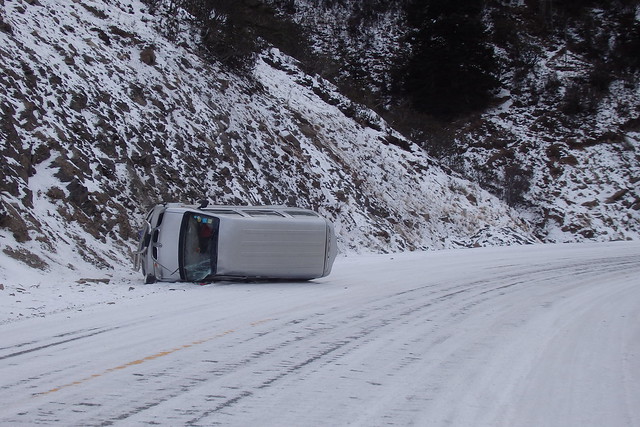
Altitude sickness is funny. I often feel pretty pathetic this high up at times. I can start to feel the lack of oxygen anywhere from above 3,000m. At 4,000m it affects my cycling – but not massively. At 4,500m it gets tough – that’s when I start getting a throbbing headache like a nasty hangover. On this occasion I was only at 4,300m but my head splitting. I didn’t sleep very well at all.
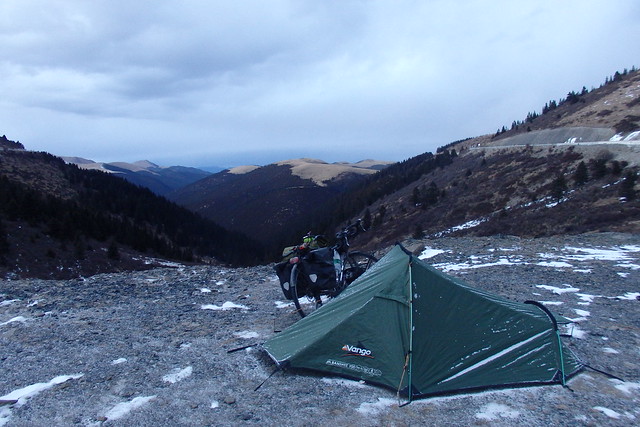
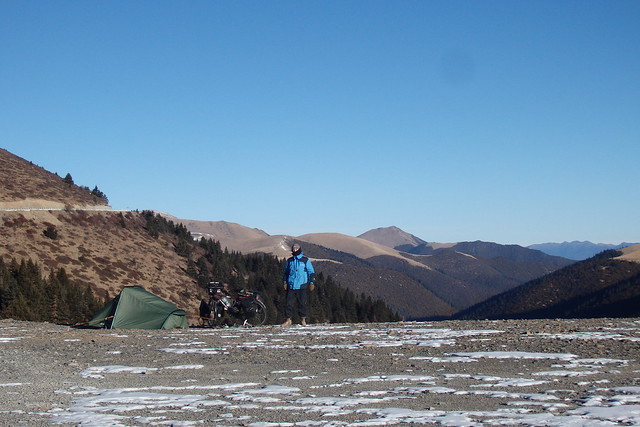
The road was stunning but hard work – above 4,000m all day and constantly rolling up and down.
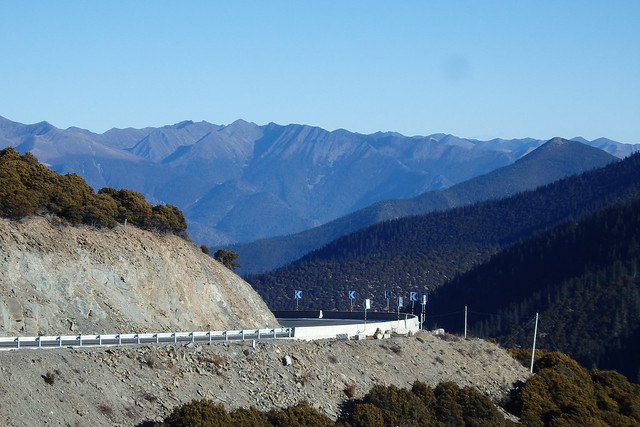
I messed up my water rations. I’d used my un-frozen water to cook breakfast but my second thermos had frozen along with my other water bottles. There were streams around but they were frozen solid and there wasn’t enough snow to melt.
I tried to reach Litang in a day but when I finally found some water I stopped before the second last pass and pitched my tent at 4,400m – the highest I’ve ever camped.
Again, I didn’t sleep very well – a combination of the bitter cold, the altitude and the howling wind.

It was hard getting started in the morning. I’ve really had enough of the cold now. It’s too much. Everything just gets so hard when you’re permanently stuck in sub-zero temperatures. Keeping water unfrozen is a nightmare, the frozen food is inedible and all electronic stuff won’t turn on. Everything lives inside the sleeping bag with me. Anything outside with any moisture on it freezes – the toothpaste, my wet wipes and even the washing up brush has frozen solid to the saucepan.
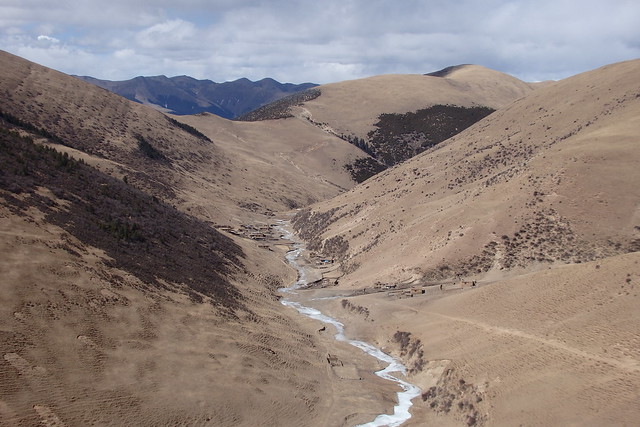
I’ve never been in temperatures like it. As I poured water from my thermos into another bottle the water froze as it entered the plastic, forming a seal over the top as I tried to move the liquid. It’s crazy.
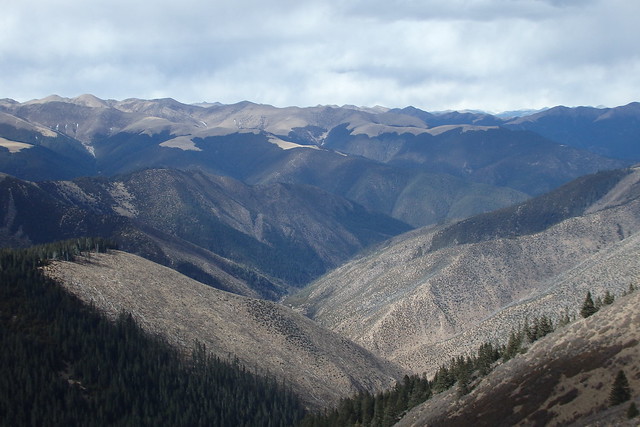
My crap tent now has another fault to an increasingly long list of problems: the zip has broken on the inner door meaning I can’t close it anymore. Not ideal when it’s super cold and snowing outside. You get a refreshing layer of snow blown in from outside.
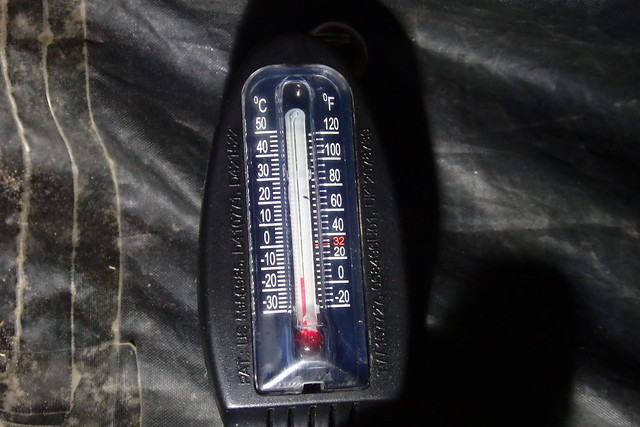
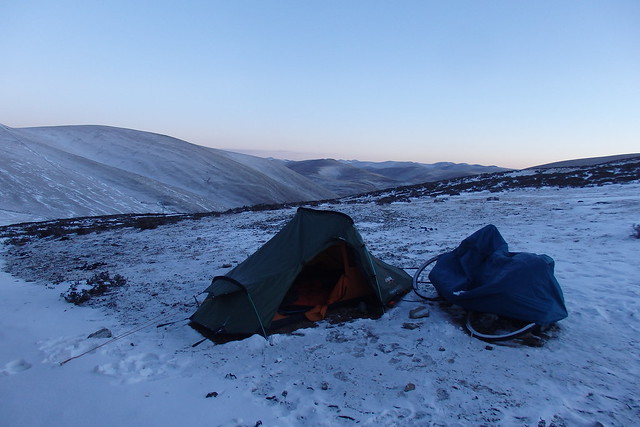
As I was packing up my tent I noticed something moving over the hill nearby. At first I thought it was a dog but as it moved closer I realised it looked a little too big. The tail was different… and the ears were pointy…
Shit. That’s a wolf.
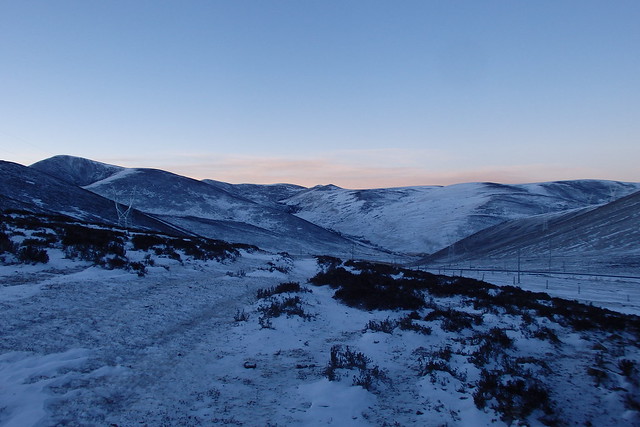
At the exact moment I realised what I was looking at it realised I was there and stopped in it’s tracks. We locked eyes for an uncomfortable amount of time.
What do you do when you’re face-to-face with a wolf?
Do I shout at it and make myself look imposing? Or is that what you do with bears?
Do I punch it on the nose? Or is that sharks…
I remembered a story in the newspaper about a Finnish kid who’d played death metal to a pack of wolves surrounding him that had scared them away. I have a small speaker with me but it’s not been able to turn on for days in this cold…
I carefully reached down to my handlebar bag by my feet, moved my hand passed the knife clipped the the side and did what any rational, terrified person would do: grabbed my camera and took a quick pic!
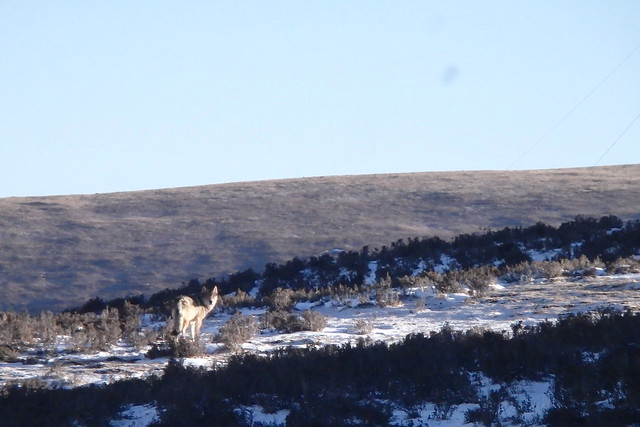
Fortunately the wolf had already had it’s breakfast and slowly walked away, stopping every few seconds to look back at me. It disappeared briefly before re-appearing on a higher hill to look down at me again. I’ve never packed up my tent so quick in my life, eager to get away before Mr. Wolf returned with more of his pals.
As I dragged my bike back onto the icy road a truck driver blasted his horn in my ear to let me know he was passing. I’d heard his ratting winter tyre chains from a mile away as he inched his way along the road. I couldn’t help but think that getting eaten by a hungry wolf would be a more glamourous end to this story than getting flattened by a heavy truck trying to navigate these dodgy roads…
I was finally in Litang. My time on the G318 had come to an end.
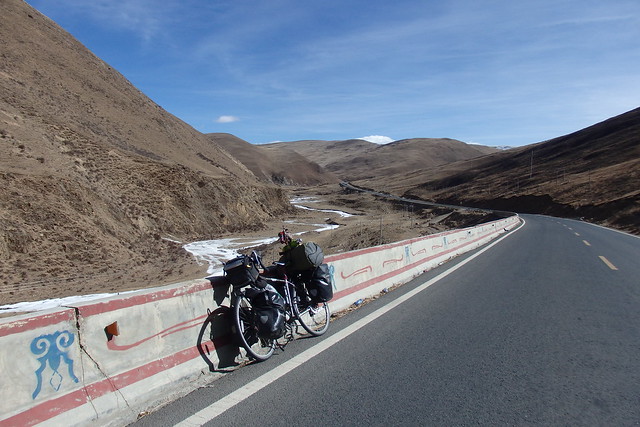
I’d have liked to stop for a night and visit the Dalai Lama’s former residence but I didn’t have time. I hoped I wasn’t missing too much.
I wrote a bit in one of my last China blogs about the complaints of the Tibetans I’d met along the way who felt victimised and oppressed in China. The Dalai Lama has reminded me of a conversation I had a while ago with a Han-Chinese bloke about Tibet: he told me he couldn’t understand why the Tibetans had a problem. The Chinese had built them good roads, new schools and improved their standard of living massively. He also said he didn’t get why the Dalai Lama was idolised so much in the west. Apparently he’d called on Tibetans to attack Han-Chinese back in 2008 (The Chinese said that he was inciting violence around that time). It was because of that that Facebook is now blocked, apparently.
It concerns me that you can have such different accounts of a story or situation so close to each other, but it’s like so many places around the world where two different groups of people living together in one country. Perhaps the closest parallel would be drawn to the conversations I had in Turkey with Turks and Kurds regarding homeland and oppression.
I stopped for lunch in Litang and some local guys asked me if I was heading to Lhasa. I’ve been asked this a lot on this road – I’m very surprised people don’t know that us foreigners aren’t allowed in. I wonder what they’d say if they did know. If I were to keep heading west I’d reach the Central Tibetan border in a couple of days and be turned away at the police checkpoint.
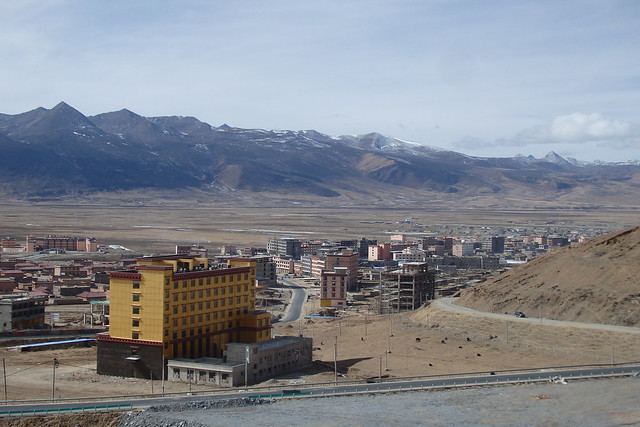
It was time for me to head south. It had been an exhausting ride but the hard part was still to come: the road to Shangri-La was even higher and far more remote. But more on that next time…
As a wise cyclist once wrote on a hostel wall: ‘G318 fuck me’.
Amazing read man! I’ll be taking the G318fuckme in a couple of months! Looking forward to it!
LikeLike
Thanks! Enjoy… it’s quite a stunner!!
LikeLike